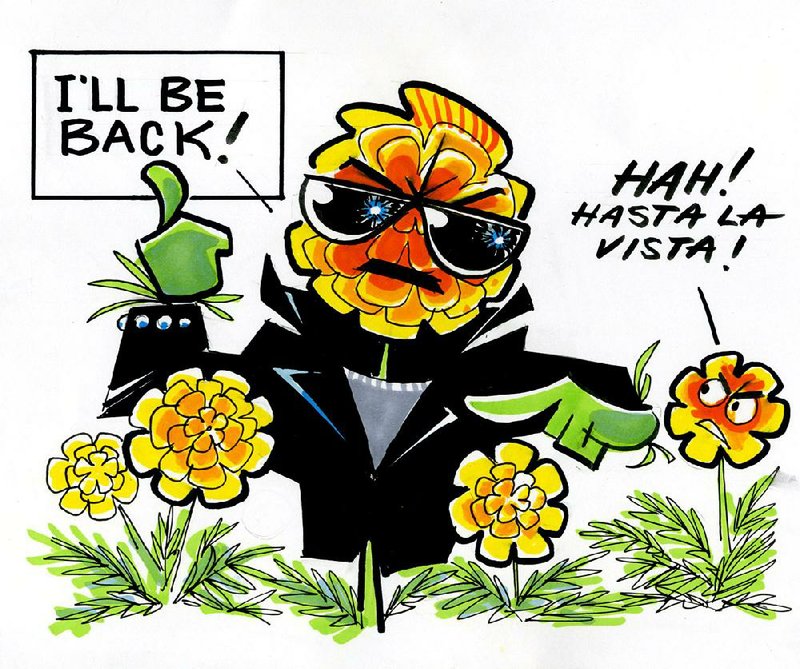Q I have a marigold that came back from a 2014 planting. We both know that marigolds are annuals. This single marigold plant is 18 inches wide and 18 inches tall. I have never seen a marigold grow to this size, and it is covered with buds along with many flowers. Amazing!
A I do not think this plant is a perennial. Marigolds set a great deal of seeds, and I think one you planted in 2014 reseeded itself. You have a replacement plant this year that has grown from seed. You can save some seeds this fall to replant in the spring after the soil warms up, or simply leave the plant in place and wait to see if it will reseed on its own. If you had a hybrid variety to begin with, the resulting seeds may look quite different from the mother plant. If you do have summer annuals that you would like to reseed, after a killing frost in the fall, instead of doing rigorous clean-up, pick the seed heads and scatter them in the garden immediately. You also could save them in a dry place for spring planting.
Q Within the past month I tilled up much of my shaded backyard and put down Raleigh St. Augustine sod. Most of it is looking good and is a solid green. However, I do have some places where I am finding dead grass among the living grass. I know it is not lacking water, and so the only thing I could think of might be lack of direct sunlight, but this area still gets at least two hours of direct sunlight.
A I do not think you would have lost that much grass due to shade this quickly. St. Augustine is the most shade-tolerant lawn grass we have. When grown in deep shade, it will thin out over time, but I don't think that would happen this quickly. Could it possibly be too wet? We have had way more rain than normal and that, coupled with extra water, could be a problem. Is the spot low so that it retains water? I'd try lightly raking out the dead grass and lightly fertilizing with a slow-release nitrogen fertilizer to see if you can get the St. Augustine to thicken up a bit.
Q I am cleaning out an iris bed about 20 inches wide by 20 feet long because it is just off my screened-in porch in Greenbrier. I would like to replace the irises with annuals or perennials that are mixed and colorful and will not grow beyond 12 inches in height but will continue to bloom throughout the summer, giving a beautiful "frame" to the front of my house. What would be your suggestions? My bed area is in pretty good shape now with a blend of soil, topsoil, Miracle-Gro and mulch, and overhead I have gutters protecting it from being drenched each time it rains.
A I think if you have a bed this large in such a visible place you should plant something evergreen so you have something growing all the time. Even a few clumps of monkey grass or liriope scattered in between the annuals and perennials would serve in this narrow space. You might also try one of the dwarf abelia shrubs or the dwarf buddleia (butterfly bush), which are mostly evergreen and bloom all summer. The new Drift roses also bloom most of the summer and stay compact. For a long-blooming perennial that grows low, you could try dwarf Ruellia "Katie," which is the Mexican petunia. It blooms purple or pink from June through September. One of the creeping verbenas in purple, pink, red or white would bloom all summer; they are treated like annuals. Another option is lantana, but definitely read the plant tag to determine maximum height as some grow way taller than 12 inches. Add a few annuals, and your bed should be colorful all summer.
Q I was trimming my holly bushes and saw that some of the leaves are black on the underside. I assume it is a pest of some type. Can this be treated with Malathion?
AI am betting your holly has scale insects on the undersurface of the leaves. These sucking insects can come in a variety of sizes and shapes, but we have been seeing more than a few of the tea type scale insects attacking a wide range of hollies this season. They look almost like a sprinkling of salt and pepper on the undersurface of the leaf. As they feed, they give off a sticky substance called honeydew, which falls on the leaves below. Wherever honeydew accumulates, black sooty mold can form. When you have scale insects, you typically need a systemic insecticide, which can be taken up by the plant so it works from the inside out. Orthene, Merit or Bayer Advanced tree and shrub insecticides should do the trick. Be aware that once the insects are dead, they will still be on the leaves, but you should not see new signs of attack.
Janet B. Carson is a horticulture specialist for the University of Arkansas Cooperative Extension Service. Write to her at 2301 S. University Ave., Little Rock, Ark. 72204 or email her at
jcarson@arkansasonline.com
HomeStyle on 07/18/2015
